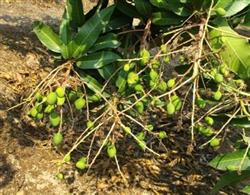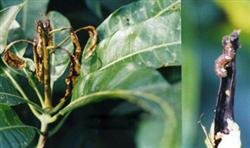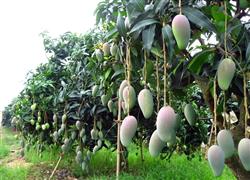What are the ways to protect flowers and fruits of mango?

What are the ways to protect flowers and fruits in mango? Mango flowering and fruit setting period is a very important period in mango production and management. The management measures of mango flowering and fruit setting period are as follows: 1. Arrangement of flowering branches and shoots. The dense branches, weak shade branches and disease and insect branches were deleted about 2 months before flower bud differentiation, and only 1-2 shoots were left on each branch, which could increase the transmittance of the crown, facilitate the concentration of nutrients and form good ventilation and light conditions. promote flower bud differentiation and prevent the occurrence of diseases and insect pests. 2. Cultivate and attract flies to pollinate. Before blooming, longan orchards pile up garbage or rett bran dung, chicken dung, salted fish fragments, livestock viscera and so on, which can cultivate and attract flies to come to the orchard to breed and pollinate. But the use of flies can only be partially pollinated. 3. Application of trace elements and calcium fertilizer. From flowering to young fruit stage, lime application can be used to reduce soil acidity and harmful iron, aluminum, manganese content and increase the level of calcitonin. Generally, 0.6-0.8 kg of lime is applied per plant, or 2% calcium chloride solution is sprayed from flowering to fruit setting. The application of zinc and boron can spray 0.2% zinc sulfate and 0.2% borax solution 10 days before flowering and after flowering and flowering to promote pollination and fruiting. When applied, it can be mixed with pesticides for foliar fertilization during pest control and irrigation at the same time. 100 grams of zinc sulfate and 50 grams of borax per plant were applied in combination with nitrogen, phosphorus and potassium fertilizer before autumn shoot germination. 4. Spraying 50~100ppm gibberellin once every 15-20 days for a total of 2-3 times, which can improve the fruit setting rate to a certain extent. Or use the following method: full flowering: spraying with 50~70PPm (made in Sichuan) + 0.3% borax spray. One week after flowering: spray with 50~70PPm (made in Sichuan) or 300x multi-effect or 1.8% Aiduo 0.5 ppm 0.2% potassium dihydrogen phosphate. 3 weeks after anthesis: sprayed with 30~50ppm "920" plus 0.3% urea. 5. Topdressing. (1) Rhizosphere topdressing: from flowering to rapid expansion of young fruit, topdressing according to tree potential and fruit amount. Nitrogen and potassium are the main fertilizers. Urea and potash fertilizer 0.3~0.5Kg were applied to each tree of less than 10 years old, and urea and potassium fertilizer were applied to each tree of more than 10 years old. Trees with less fruit could not add nitrogen fertilizer but only potassium fertilizer, and each tree could apply potash fertilizer 0.3~1.0Kg according to the age of the tree. During the period of fruit growth, the weak trees with more fruit can also be supplemented with appropriate amount of nitrogen and potassium fertilizer in June. (2) extra-root topdressing: 0.3% boric acid and 0.2-0.3% potassium dihydrogen phosphate were sprayed once at full flowering stage, final flowering stage and young fruit stage. 6. thinning fruit and pruning fruit branches. Fruit thinning within 15-30 days after flowering, the young fruit was thinned when it was the size of peanut seeds, and only 2-4 fruits per panicle were retained, with the better position in the center, and the young fruits with larger, bright green color and strong growth vitality were selected. the remaining fruits were evenly distributed in the crown and among branches, and it was advisable that the fruits were not close to each other. After the mango falls physiologically, the ear axis is difficult to fall off naturally, so it should be cut off manually so as not to scratch the pericarp and affect the appearance. However, the varieties of Aiwen and Jinhuangmango should be preserved. 7. Promote coloring. Some varieties with good red skin, such as Hongmang 6, Aiwenmang, etc., remove the shady branches, disease and insect branches that cover the fruit during pruning in the middle fruit stage, so that a fruit can receive sufficient light and color evenly. Spraying 70% nitriloquinone wettable powder once or twice before bagging the fruit can make the appearance of Ai Wen Mang ruddy. Spraying 50% carbendazim wettable powder can promote the tenderness of the pericarp and produce fruit powder. Spraying 80% sulfur wettable powder can promote the red and yellow color of the pericarp and produce fruit powder. 8. Bagging. The fruit development period of mango is high temperature and rainy season. Fruit bagging is the best way to protect the fruit from diseases and pests. Spray sterilization and insecticides before bagging, or put the paper bag into the liquid after soaking, fasten it tightly, and leave a leak at the bottom of the bag to remove stagnant water in the bag. no, no, no. The sizes of mango bags vary according to varieties. The general specifications are: 22 cm long and 15 cm wide. The paper bag material can be made of white wax paper, black Kraft paper and non-woven fabric. Bagging time is generally after the fruit is basically stable, that is, the end of the second physiological fruit drop, when the fruit grows and develops to the size of an egg. Zi Hua Mang was bagged about 35 days after Xie flower, and Ai Wen Mang was carried out 30-50 days before Xie harvest, which was beneficial to fruit coloring. Jin Huang Mang can be bagged early or 45 days before harvest. Click to get more mango planting techniques click to get more fruit planting techniques
- Prev

How to control diseases and insect pests of mango
How to control mango diseases and insect pests? What are the effective methods? The comprehensive control of mango diseases and insect pests carries out the plant protection policy of "prevention first and comprehensive control". On the basis of improving orchard ecological environment and strengthening cultivation management, various control measures are comprehensively applied, giving priority to agricultural measures, biological control and physical control.
- Next

How to manage mango trees in spring
How to transform low-yield mango orchard? The main technical measures to guide the transformation of mature mango orchard are as follows: (1) thinning every other plant, row spacing 1? In the orchard of 5 m ×4 m, one plant was cut every other plant, the row spacing was changed to 3 m, and the row spacing after transformation was 3 m ×4 m. (2) High-grafting new excellent varieties High-grafting varieties are red...
Related
- Moge, come on! The staff of the peasant association in the producing area of cantaloupe were frightened when the crowd gathered.
- Causes and Solutions of low Fruit setting rate of Apple
- Symptoms and control measures of passion fruit virus disease
- Fruit growing lesson: how do apple orchards keep high yields?
- Can you build orchards in the mountains? What are the pros and cons?
- How to manage the coloring period of Crisson grape?
- This paper introduces the processing technology of two kinds of fig products.
- How much is a month for retired teachers in rural areas by 2020?
- How can strawberry planting increase sugar content? We should pay attention to management in many aspects.
- What are the cultivation techniques on how to improve the yield of golden fruit?

